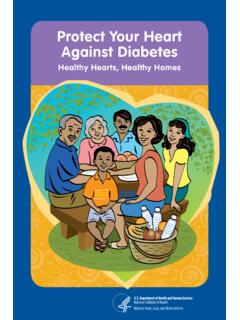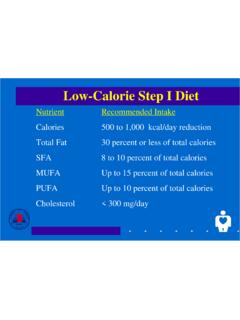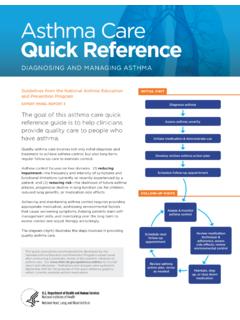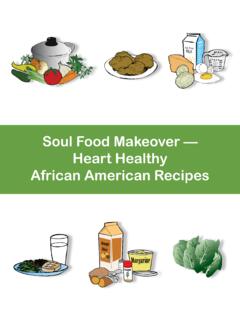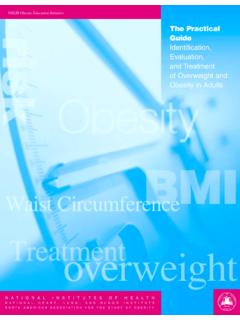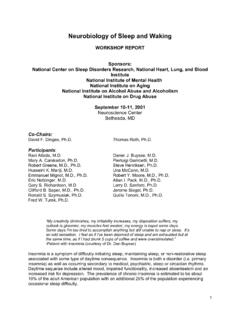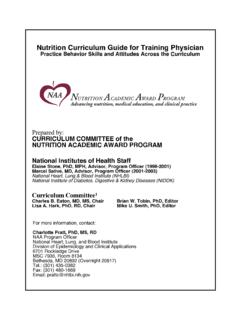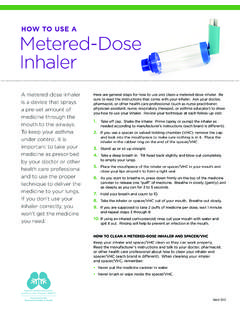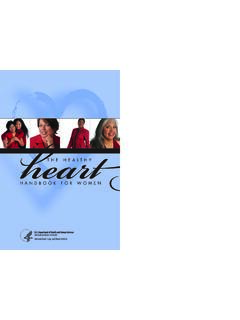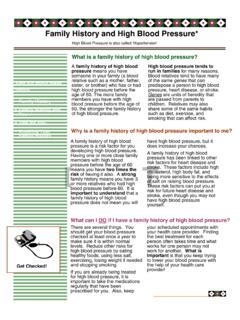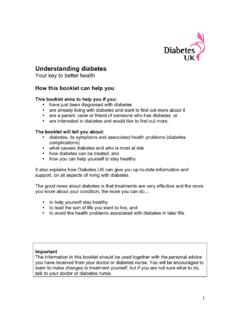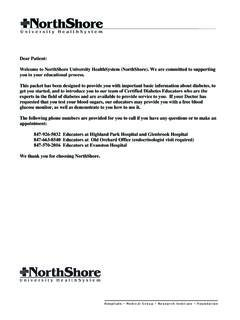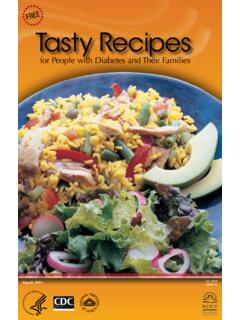Transcription of Your Guide to Lowering Blood Pressure
1 Your Blood PressureLoweringGuide DEPARTMENT OF HEALTH AND HUMAN SERVICESN ational Institutes of HealthNational Heart, Lung, and Blood InstituteYour Guideto LoweringBlood Pressure2 What Are high Blood Pressure and Prehypertension? Blood Pressure is the force of Blood against the walls of arteries. Blood Pressure rises and falls throughout the day. When Blood Pressure stays elevated over time, it s calledhigh Blood medical term for high Blood Pressure is Blood Pressure is danger-ous because it makes the heart work too hard and contributes to atherosclerosis (hardeningof the arteries). It increases the risk of heart disease (see box 1) and stroke, which are thefirst- and third-leading causes of death among Americans.
2 high Blood Pressure also canresult in other conditions, such as congestive heart failure, kidney disease, and Blood Pressure level of 140/90 mmHg or higher is considered high . About two-thirdsof people over age 65 have high Blood Pressure . If your Blood Pressure is between 120/80 mmHg and 139/89 mmHg, then you have means that youdon t have high Blood Pressure now but are likely to develop it in the future unless youadopt the healthy lifestyle changes described in this brochure. (See box 2.)People who do not have high Blood Pressure at age 55 face a 90 percent chance of developing it during their lifetimes. So high Blood Pressure is a condition that most people will have at some point in their numbers in a Blood Pressure test are important, but for people who are age 50 or older, systolic Pressure gives the most accurate diagnosis of high Blood Pressure is the top number in a Blood Pressure reading.
3 It is high if it is 140 mmHg or above. Risk Factors for Heart DiseaseRisk factors are conditions or behaviors that increase your chances of developing a disease. When you havemore than one risk factor for heart disease, your risk of developing heart disease greatly multiplies. So ifyou have high Blood Pressure , you need to take action. Fortunately, you can control most heart disease risk factors you can control:Risk factors beyond your control: high Blood Pressure Age (55 or older for men; 65 or older for women) Abnormal cholesterol Family history of early heart disease (having a father or Tobacco usebrother diagnosed with heart disease before age 55 or Diabeteshaving a mother or sister diagnosed before age 65) Overweight Physical inactivitybox 1 How Can You Prevent or Control high Blood Pressure ?
4 If you have high Blood Pressure , you and your health care provider need to work together asa team to reduce it. The two of you need to agree on your Blood Pressure goal. Together, youshould come up with a plan and timetable for reaching your Pressure is usually measured in millimeters of mercury (mmHg) and is recorded astwo numbers systolic Pressure (as the heart beats) over diastolic Pressure (as the heartrelaxes between beats) for example, 130/80 mmHg. Ask your doctor to write down foryou your Blood Pressure numbers and your Blood Pressure goal your Blood Pressure at home between visits to your doctor can be also may want to bring a family member with you when you visit your a family member who knows that you have high Blood Pressure and who under-stands what you need to do to lower your Blood Pressure often makes it easier to makethe changes that will help you reach your steps listed in this brochure will help lower your Blood Pressure .
5 If you have normalblood Pressure or prehypertension, following these steps will help prevent you fromdeveloping high Blood Pressure . If you have high Blood Pressure , following these stepswill help you control your Blood brochure is designed to help you adopt a healthier lifestyle and remember to takeprescribed Blood Pressure - Lowering drugs. Following the steps described will help youprevent and control high Blood Pressure . While you read them, think to yourself .. I Can Do It! 3 Blood Pressure Levels for AdultsSystolic Diastolic Category(mmHg) (mmHg) ResultGood for you!Your Blood Pressure couldbe a problem. Makechanges in what you eatand drink, be physicallyactive, and lose extraweight.
6 If you also havediabetes, see your have high Blood pres-sure. Ask your doctor ornurse how to control 2 NormalPrehypertensionHypertensionless than 120 and120 139 or140 or higher orless than 8080 8990 or higher*For adults ages 18 and older who are not on medicine for high Blood Pressure and do not have a short-term serious illness. Source: The Seventh Report of the Joint National Committee on Prevention, Detection, Evaluation, and Treatment of high Blood Pressure ; NIH Publication No. 03-5230,National high Blood Pressure Education Program, May 2003. If systolic and diastolic pressures fall into different categories, overall status is the higher category.
7 Millimeters of canalmost alwaysbe prevented, so thesesteps are very importanteven if you do not havehigh Blood Pressure . Maintain a healthy weight . Be physically active. Follow a healthy eating plan. Eat foods with less sodium (salt). Drink alcohol only in moderation. Take prescribed drugs as directed.*Being overweight or obese increases your risk of developing high Blood Pressure . In fact,your Blood Pressure rises as your body weight increases. Losing even 10 pounds canlower your Blood Pressure and losing weight has the biggest effect on those who areoverweight and already have and obesity are also risk factors for heart disease.
8 And being overweight orobese increases your chances of developing high Blood cholesterol and diabetes twomore risk factors for heart key measures are used to determine if someone is overweight or obese. These arebody mass index, or BMI, and waist is a measure of your weight relative to your height. It gives an approximation oftotal body fat and that s what increases the risk of diseases that are related to BMI alone does not determine risk. For example, in someone who is very muscularor who has swelling from fluid retention (called edema), BMI may overestimate body may underestimate body fat in older persons or those losing s why waist measurement is often checked as well.
9 Another reason is that too muchbody fat in the stomach area also increases disease risk. A waist measurement of morethan 35 inches in women and more than 40 inches in men is considered the chart in box 3 for your approximate BMI value. Check box 4 to see if you areat a normal weight , overweight, or obese. Overweight is defined as a BMI of 25 to ;obesity is defined as a BMI equal to or greater than you fall in the obese range according to the guidelines in box 4, you are at increasedrisk for heart disease and need to lose weight . You also should lose weight if you areoverweight and have two or more heart disease risk factors.
10 (See box 1.) If you fall in thenormal weight range or are overweight but do not need to lose pounds, you still shouldbe careful not to gain YOURT arget WeightLower YourBlood Pressureby Aiming for aHealthy WeightIf you need to lose weight , it s important to do so slowly. Lose no more than 1/2pound to 2 pounds a week. Begin with a goal of losing 10 percent of your current weight . This is the healthiest way to lose weight and offers the best chance of long-term s no magic formula for weight loss. You have to eat fewer calories than you use upin daily activities. Just how many calories you burn daily depends on factors such as yourbody size and how physically active you are.
